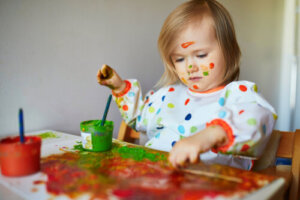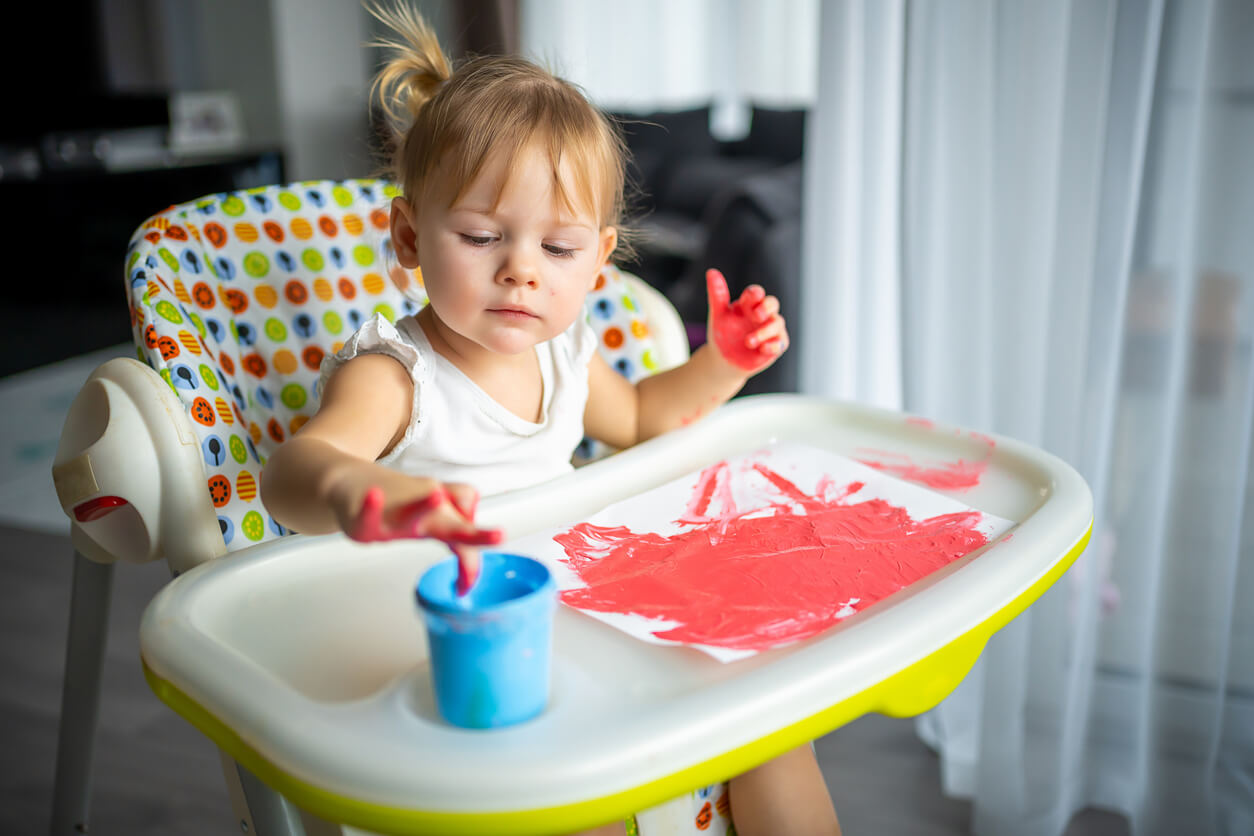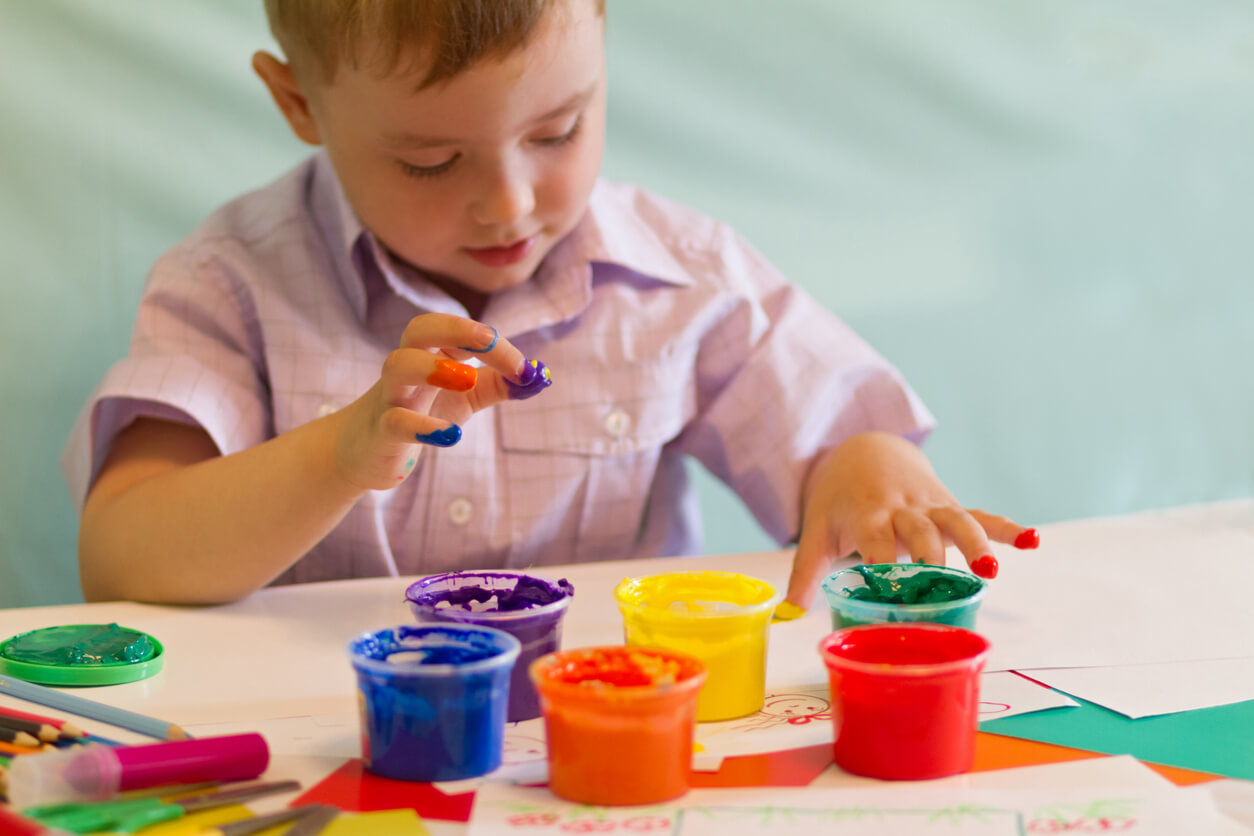7 Benefits of Finger Painting for Children

Creating drawings with their hands is one of the most fun educational activities for little ones. This colorful game allows them to develop their sense of touch and awaken their creativity. In this article, we’ll tell you all the benefits of finger painting for children.
Finger painting is an activity that favors children’s imagination and ingenuity, in addition to introducing them to the world of artistic, visual, and textural expression.
To finger paint, you only need to buy natural paint, and some sheets of paper or cardboard and encourage your child to take part in this pleasant activity. It’s important to know that any child can do it from six months of age with proper parental supervision. Let’s see all the benefits of finger painting that your child can enjoy!
Know the benefits of finger painting for children
Awakened creativity, motor skill development, and learning to identify and differentiate colors, are just some of the benefits of finger painting for children. Here is a list of qualities that your child can develop by applying this technique:
1. Awaken creativity and imagination
Through art, children can express their emotions in a natural and playful way. Therefore, finger painting is useful for them to express their emotions and awaken their creativity and their capacity for imagination and inventiveness. In addition, with finger painting, babies can take their first steps into the world of art.

2. Stimulates motor coordination
Another benefit of finger painting for children is the development of motor coordination. Spreading the paint out on the paper favors skills that haven’t yet been consolidated in the child, such as manual dexterity.
In this technique, children have the opportunity to discover textures, which positively influences fine motor skills. Therefore, it contributes to the mastery of hands, fists, and fingers. Painting is as stimulating for infants’ motor development as writing or cutting out shapes.
3. Boosts self-esteem
Giving children the freedom to create whatever they want, without the need to use any tools other than their own hands, increases their self-esteem and independence. If you also congratulate them for their work, you’ll help strengthen their self-esteem and they’ll feel amazed to have created something great without anyone’s help.
4. Allows him to learn about textures and colors
Using nothing more than their hands, fingers, and wrists to capture what they want on paper helps the child to develop tactile sensitivity. At the same time, they gain knowledge of what smooth and wet textures are. And if instead of smooth paper you provide a corrugated one, the experience will be much more fascinating.
This technique will also help the child to stimulate vision in order to identify and differentiate colors. They’ll also be able to mix them and create different shades.
5. Promotes concentration
Among the many benefits of finger painting is the improvement of concentration. This is because when children paint, they focus their attention only on what they’re doing, without being distracted by other things. This way, they also cultivate patience and attention, qualities that will serve them for life.

6. It helps to relax
Painting is a calm activity, which is even done in silence, which characterizes it as one of the most relaxing artistic expressions that exist. At the same time, it helps children stay calm.
7. You will have a fun time
Finger painting allows children to have a lot of fun and enjoy themselves while sharing a moment with their family. Organize a family afternoon in which both adults and children can enjoy painting and have a good time. It’s best to accompany the moment with a snack that your children like.
Recommendations for finger painting with children
If you’re going to finger paint with your child, here are some recommendations for carrying out this activity at home:
- When buying paint at the store, make sure it’s safe and non-toxic. It’s important that it comes off when washing hands with soap and water and that it has a texture that makes it easy for children to paint.
- Do this activity from the age of six months and beyond. At this age, children are already prepared to develop their sense of touch and artistic sensibility.
- From six months to two years of age, it’s important to supervise the child, as they may put their hands in their mouth and ingest paint.
- When your child’s going to paint, put them in an apron or comfortable clothes that you don’t mind getting dirty.
- Have a damp cloth handy to wipe fingers when your child needs to change colors.
- Find the ideal space to paint. It can be a work table or on the floor. You can cover the surface with cardboard, newspaper, or an old blanket.
- Some children don’t like to get dirty, so if they don’t want to paint, don’t force them.
Multicolored fun at home
Having fun and learning at home together with your children can be very easy, practical, and economical. You can simply use fingerpainting as an artistic expression. Encourage your children and the whole family to create happily and freely!
Creating drawings with their hands is one of the most fun educational activities for little ones. This colorful game allows them to develop their sense of touch and awaken their creativity. In this article, we’ll tell you all the benefits of finger painting for children.
Finger painting is an activity that favors children’s imagination and ingenuity, in addition to introducing them to the world of artistic, visual, and textural expression.
To finger paint, you only need to buy natural paint, and some sheets of paper or cardboard and encourage your child to take part in this pleasant activity. It’s important to know that any child can do it from six months of age with proper parental supervision. Let’s see all the benefits of finger painting that your child can enjoy!
Know the benefits of finger painting for children
Awakened creativity, motor skill development, and learning to identify and differentiate colors, are just some of the benefits of finger painting for children. Here is a list of qualities that your child can develop by applying this technique:
1. Awaken creativity and imagination
Through art, children can express their emotions in a natural and playful way. Therefore, finger painting is useful for them to express their emotions and awaken their creativity and their capacity for imagination and inventiveness. In addition, with finger painting, babies can take their first steps into the world of art.

2. Stimulates motor coordination
Another benefit of finger painting for children is the development of motor coordination. Spreading the paint out on the paper favors skills that haven’t yet been consolidated in the child, such as manual dexterity.
In this technique, children have the opportunity to discover textures, which positively influences fine motor skills. Therefore, it contributes to the mastery of hands, fists, and fingers. Painting is as stimulating for infants’ motor development as writing or cutting out shapes.
3. Boosts self-esteem
Giving children the freedom to create whatever they want, without the need to use any tools other than their own hands, increases their self-esteem and independence. If you also congratulate them for their work, you’ll help strengthen their self-esteem and they’ll feel amazed to have created something great without anyone’s help.
4. Allows him to learn about textures and colors
Using nothing more than their hands, fingers, and wrists to capture what they want on paper helps the child to develop tactile sensitivity. At the same time, they gain knowledge of what smooth and wet textures are. And if instead of smooth paper you provide a corrugated one, the experience will be much more fascinating.
This technique will also help the child to stimulate vision in order to identify and differentiate colors. They’ll also be able to mix them and create different shades.
5. Promotes concentration
Among the many benefits of finger painting is the improvement of concentration. This is because when children paint, they focus their attention only on what they’re doing, without being distracted by other things. This way, they also cultivate patience and attention, qualities that will serve them for life.

6. It helps to relax
Painting is a calm activity, which is even done in silence, which characterizes it as one of the most relaxing artistic expressions that exist. At the same time, it helps children stay calm.
7. You will have a fun time
Finger painting allows children to have a lot of fun and enjoy themselves while sharing a moment with their family. Organize a family afternoon in which both adults and children can enjoy painting and have a good time. It’s best to accompany the moment with a snack that your children like.
Recommendations for finger painting with children
If you’re going to finger paint with your child, here are some recommendations for carrying out this activity at home:
- When buying paint at the store, make sure it’s safe and non-toxic. It’s important that it comes off when washing hands with soap and water and that it has a texture that makes it easy for children to paint.
- Do this activity from the age of six months and beyond. At this age, children are already prepared to develop their sense of touch and artistic sensibility.
- From six months to two years of age, it’s important to supervise the child, as they may put their hands in their mouth and ingest paint.
- When your child’s going to paint, put them in an apron or comfortable clothes that you don’t mind getting dirty.
- Have a damp cloth handy to wipe fingers when your child needs to change colors.
- Find the ideal space to paint. It can be a work table or on the floor. You can cover the surface with cardboard, newspaper, or an old blanket.
- Some children don’t like to get dirty, so if they don’t want to paint, don’t force them.
Multicolored fun at home
Having fun and learning at home together with your children can be very easy, practical, and economical. You can simply use fingerpainting as an artistic expression. Encourage your children and the whole family to create happily and freely!
All cited sources were thoroughly reviewed by our team to ensure their quality, reliability, currency, and validity. The bibliography of this article was considered reliable and of academic or scientific accuracy.
- Aranda K, Ramírez D. Influencia de la dactilopintura en el desarrollo de la motricidad fina en niños de 4 a 5 años. Ecuador: Universidad de Guayaquil; 2018. Disponible en: http://repositorio.ug.edu.ec/handle/redug/32873
- Macías C, Murillo M. Importancia de la dactilopintura en el desarrollo cognitivo de los niños de 3 a 4 años. Ecuador: Universidad de Guayaquil; 2015. Disponible en: http://repositorio.ug.edu.ec/handle/redug/14245
- García R. La dactilopintura como actividad para desarrollar su motricidad fina en los niños de educación inicial. Perú: Universidad Nacional de Tumbes; 2018. Disponible en: http://repositorio.untumbes.edu.pe/handle/20.500.12874/988
This text is provided for informational purposes only and does not replace consultation with a professional. If in doubt, consult your specialist.








